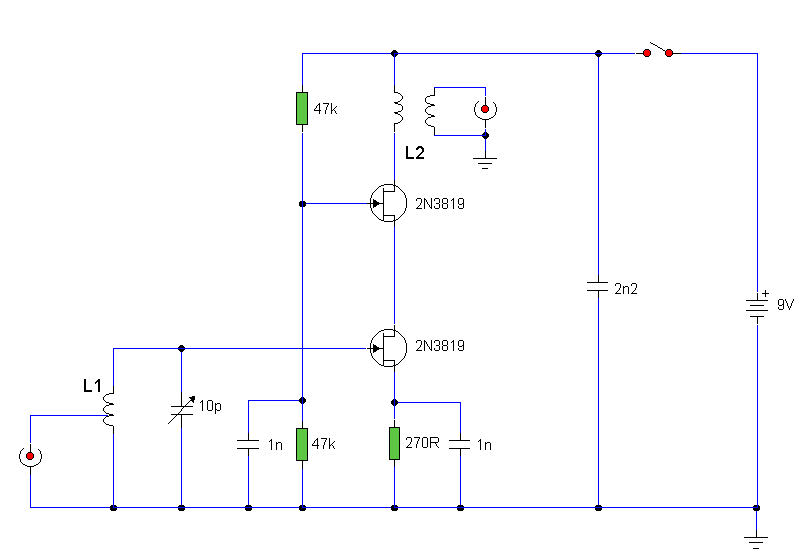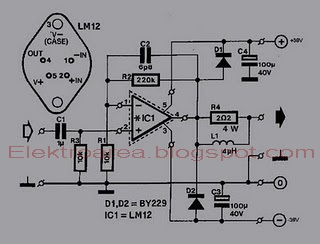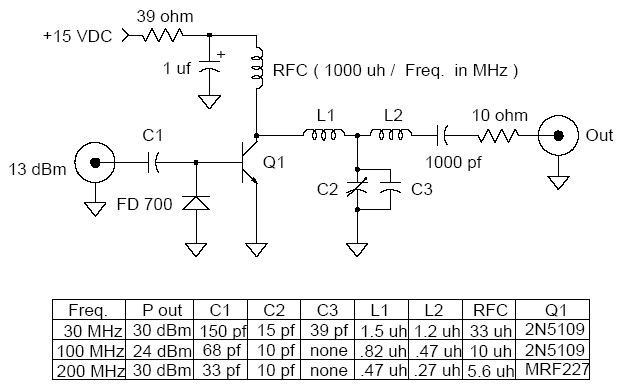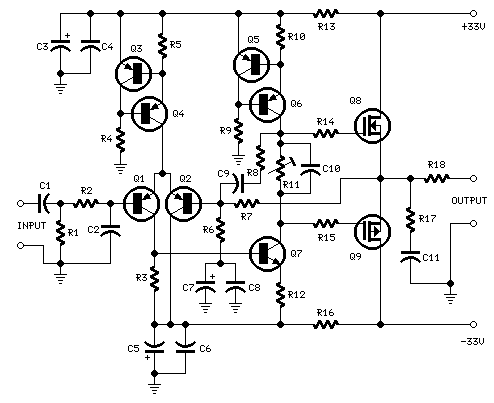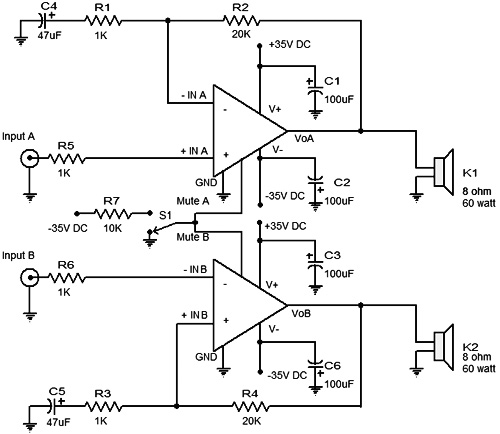
USB Powered mini Amplifier
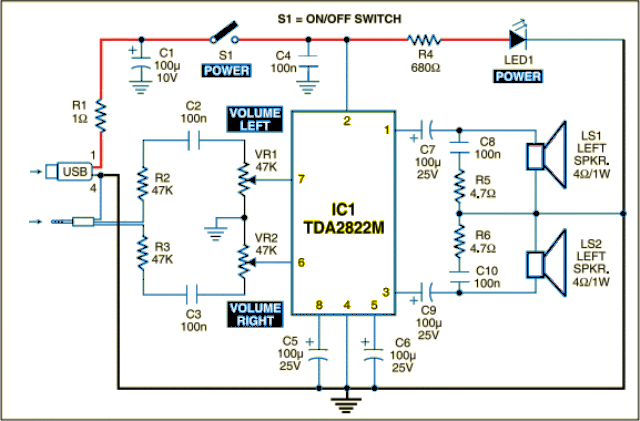
The circuit is designed as a dual audio power amplifier for use in battery-operated sound players. The TDA2822M specifications include low quiescent current, minimal crossover distortion, a supply voltage as low as 1.8 volts, and a minimum output power of approximately 450 mW per channel when connected to a 4-ohm loudspeaker at a 5V DC supply. An ideal power amplifier can be defined as a circuit capable of delivering audio power to external loads without introducing significant signal distortion and while maintaining low quiescent current consumption. Audio signals from the PC audio socket or headphone socket are transmitted to the amplifier circuit through components R2 and C2 for the left channel, and R3 and C3 for the right channel. Potentiometer VR1 serves as the volume control for the left (L) channel, while potentiometer VR2 serves the right (R) channel. Pin 7 of the TDA2822M receives the left-channel audio signals, and pin 6 receives the right-channel signals through VR1 and VR2, respectively. The amplified audio signals for driving the left and right loudspeakers are available at pins 1 and 3 of IC1.
The TDA2822M is a versatile integrated circuit designed for audio amplification applications, particularly in portable devices where power efficiency is crucial. The low quiescent current characteristic allows the circuit to operate effectively in battery-powered systems, maximizing battery life while providing sufficient audio output. The dual-channel configuration enables stereo sound reproduction, making it suitable for various audio applications.
In the schematic, the audio input is connected to the amplifier through coupling capacitors (C2 and C3), which block any DC offset from the audio source, ensuring that only the AC audio signals are amplified. Resistors R2 and R3 serve as input resistors that help in setting the input impedance of the amplifier, ensuring compatibility with different audio sources.
The volume control is implemented using variable resistors (VR1 and VR2), allowing users to adjust the audio level for the left and right channels independently. This feature enhances user experience by providing control over the sound balance. The output from the amplifier is delivered through pins 1 and 3, which are connected to the loudspeakers. The design ensures that the amplified signals are capable of driving 4-ohm speakers efficiently, producing clear and powerful audio output.
Overall, this circuit exemplifies a practical approach to audio amplification in compact, battery-operated devices, combining efficient power use with high-quality sound reproduction. The inclusion of adjustable volume control adds to its usability, making it suitable for a range of applications from personal audio devices to small sound systems.It is intended for use as a dual audio power amplifier in battery-powered sound players. Specifications of TDA2822M are low quiescent current, low crossover distortion, supply voltage down to 1. 8 volts and minimum output power of around 450 mW/channel with 4-ohm loudspeaker at 5V DC supply input.
An ideal power amplifier can be simply defined as a circuit that can deliver audio power into external loads without generating significant signal distortion and without consuming excessive quiescent current. Audio signals from the PC audio socket/headphone socket are fed to the amplifier circuit through components R2 and C2 (left channel), and R3 and C3 (right channel).
Potenciometer VR1 works as the volume controller for left (L) channel and potmeter VR2 works for right (R) channel. Pin 7 of TDA2822M receives the left-channel sound signals and pin 6 receives the right-channel signals through VR1 and VR2, respectively.
Amplified signals for driving the left and right loudspeakers are available at pins 1 and 3 of IC1. 🔗 External reference
The TDA2822M is a versatile integrated circuit designed for audio amplification applications, particularly in portable devices where power efficiency is crucial. The low quiescent current characteristic allows the circuit to operate effectively in battery-powered systems, maximizing battery life while providing sufficient audio output. The dual-channel configuration enables stereo sound reproduction, making it suitable for various audio applications.
In the schematic, the audio input is connected to the amplifier through coupling capacitors (C2 and C3), which block any DC offset from the audio source, ensuring that only the AC audio signals are amplified. Resistors R2 and R3 serve as input resistors that help in setting the input impedance of the amplifier, ensuring compatibility with different audio sources.
The volume control is implemented using variable resistors (VR1 and VR2), allowing users to adjust the audio level for the left and right channels independently. This feature enhances user experience by providing control over the sound balance. The output from the amplifier is delivered through pins 1 and 3, which are connected to the loudspeakers. The design ensures that the amplified signals are capable of driving 4-ohm speakers efficiently, producing clear and powerful audio output.
Overall, this circuit exemplifies a practical approach to audio amplification in compact, battery-operated devices, combining efficient power use with high-quality sound reproduction. The inclusion of adjustable volume control adds to its usability, making it suitable for a range of applications from personal audio devices to small sound systems.It is intended for use as a dual audio power amplifier in battery-powered sound players. Specifications of TDA2822M are low quiescent current, low crossover distortion, supply voltage down to 1. 8 volts and minimum output power of around 450 mW/channel with 4-ohm loudspeaker at 5V DC supply input.
An ideal power amplifier can be simply defined as a circuit that can deliver audio power into external loads without generating significant signal distortion and without consuming excessive quiescent current. Audio signals from the PC audio socket/headphone socket are fed to the amplifier circuit through components R2 and C2 (left channel), and R3 and C3 (right channel).
Potenciometer VR1 works as the volume controller for left (L) channel and potmeter VR2 works for right (R) channel. Pin 7 of TDA2822M receives the left-channel sound signals and pin 6 receives the right-channel signals through VR1 and VR2, respectively.
Amplified signals for driving the left and right loudspeakers are available at pins 1 and 3 of IC1. 🔗 External reference
Warning: include(partials/cookie-banner.php): Failed to open stream: Permission denied in /var/www/html/nextgr/view-circuit.php on line 713
Warning: include(): Failed opening 'partials/cookie-banner.php' for inclusion (include_path='.:/usr/share/php') in /var/www/html/nextgr/view-circuit.php on line 713
